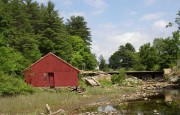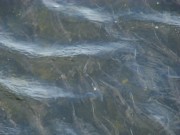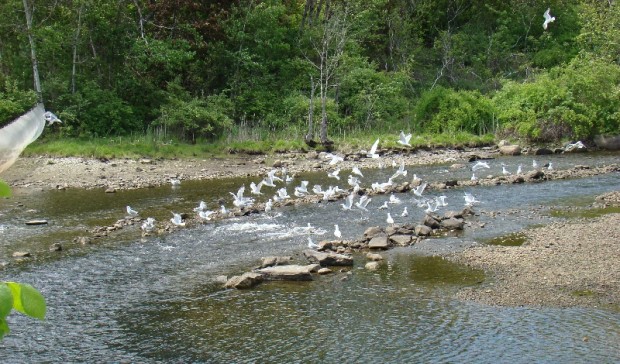
In the early 1600’s a dam was built in Nequasset, now a portion of Woolwich. It was the early primary power source for the town, the site of grist, saw, and fulling mills. The original wooden fishway provided a rich harvest of alewives, which was apportioned among the residents according to their needs, with widows and older people given preference.
Alewives schooling and awaiting their turn to run up stream at Damariscotta Mills in Newcastle in 2008.
A welcoming committee of seagulls ready to feast on slow moving alewives at Damariscotta Mills in 2008. Click to enlarge.
are small fish that return in great number to spawn in lakes primarily in the Lincoln County area. Once abundant, the fishery was suspended for one year in 1991 as it was about to collapse. (See alewife landings information and chart.) Since then, the number of alewives returning to spawn in the spring has increased dramatically. Damariscotta Lake is a major destination for adults with intentions of spawning the next generation. The fishway near the dam at Damariscotta Mills in Newcastle provides access to and from the lake. During the peak of the season in 2001, 352 alewives were counted heading into the lake at the top of the fishway in a ten minute period. See historical data on Alewife Landings.
Wildlife such as osprey, grebe, cormorant, merganser, heron, gulls and raccoon thrive on the fish feast.
Though consumed for food in the 19th century, the current use is primarily as bait for lobsters. Local tradition, and sometimes ordinances, decreed that widows receive two bushels free each year. The poor were also granted special allotments of the usually bountiful harvest.
According to the Maine Department of Marine Resources,
The alewife is a sea-run fish species native to the North American continent. Spawning populations of alewives are found in rivers and streams from Newfoundland to South Carolina. Every spring, adults ascend rivers and streams to spawn in freshwater lake and pond areas. After the eggs hatch, the young-of-the-year spend two to six months in the freshwater environment, growing 1½ to 5 inches in size before they begin to migrate to sea. Adult and juvenile alewives are planktivorous (main food source is zooplankton), although they occasionally eat insects and fish larvae, including larval alewives.
Alewives are important to the ecology of the freshwater, estuarine, and marine environment. The adults and young provide a food source for striped bass, brown trout, salmonid species, eels, ospreys, eagles, kingfishers, cormorants, and aquatic fur bearing mammals. Adult alewives are a preferred bait for the spring lobster fishery. There are 35 Maine municipalities that have commercial harvesting rights to alewives on 39 coastal streams and rivers. These runs provide revenue to the towns, which lease their fishing privileges to independent fishermen. Many of the fishways built for alewife restoration on some of our small coastal streams were partially funded by these municipalities as they recognized the value of this native fish species. Since the early 1970s, over 12 million dollars of state, federal, and private utility funds have been spent on fish passages to restore runs of Atlantic salmon, alewife, and American shad to historical spawning areas.
According to the Maine State Planning Office, citing historical sources:
Alewives ascended the Kennebec as far as Norridgewock (91 miles) and up the Sandy River (110 miles). From a French priest’s letter written from Norridgewock in 1723: “At a particular season of the year, they [the Indians] repair to a river not far distant, where during one month the fish ascend in such numbers that a person could fill 50,000 barrels in a day, if he could endure the labor. They are a kind of large herring, very agreeable to the taste when fresh. Crowding one upon another to the depth of a foot, they are drawn out as if they were water.”
At Fort Western (now Augusta), alewives were shipped down the Kennebec by the Howard family who operated a store within the fort. Three account books survive from the mid 1700s to the early 1800s. The following shipments of alewives were made:
1773 14,000 lbs; 1774 105,000 lbs; 1775 14,200 lbs
A diary entry of the Rev. Paul Coffin on July 30, 1776 reads: “Rode two miles to Capt. Jonathan Philbirck’s on Sebasticook, just above the falls, where they catch herring [alewives] and shad. Thousands of barrels of herring have been taken this spring. … Mr. Hudson had three thousand of them hanging over one’s head in his shop or smokehouse.”
In 1797, Capt. Timothy Heald in Winslow sold over 1,000 barrels of alewives which were sent to the West Indies. At two hundred pounds of fish per barrel, he handled over 200,000 pounds of alewives in that one year.
Alewives were a cash crop in Vassalboro, Clinton, and Newport. Clinton’s catch is estimated to have been 3,000 bushels (1,200,000 alewives) a year in the early 1800s, with the auction of the fishing rights bringing in $500 to $1,200 each year to the town government. By order of the Clinton Town Meeting in 1815, every inhabitant was authorized to receive “a quantity of fish not exceeding 200 to each individual.”
During an eighteen-day period in the spring of 1824, William Getchell of Waterville (at Ticonic Falls) sold 26 barrels (5,200 pounds) of alewives.
The Penobscot Restoration Trust reports
On the morning of May 26, 1826 the Kennebec Journal informed its readers: “A true fish story — Seven thousand shad and nearly a hundred barrels of alewives were taken in Eddington last week by Luther Eaton, Esq. at one haul — Bangor Register.” Until the 1830s, there were no dams on the Penobscot. Salmon, shad and alewives traveled 100 miles upriver to Shad Pond in Millinocket, Island Falls on the Mattawamkeag, and Monson on the Piscataquis.
The construction of a large dam at Eddington Bend in 1834, without any passage for fish, dealt a serious blow to the fishing industry in the lower Penobscot.
Additional resources
Closing the Circle: the Alewife Run, Damariscotta Mills, Maine. [moving images recording] Michael Richard, director; Wendy Hebb, producer; Red Door Media, c2005.
Demi, Lee Michael. Anadromous Alewives in Linked Lake Stream Ecosystems: can trophic interactions in lakes influence streams. Thesis (M.S.) in Ecology and Environmental Science–University of Maine, 2010.
Maine Department of Marine Resources, “Fact Sheet – Anadromous Alewife.” http://www.state.me.us/dmr/rm/alewifefactsheet.htm. Maine State Planning Office, “History of the Edwards Dam Facilities. http://www.state.me.us/spo/sp/edwards/morehistory.php (accessed September 14, 2005).
Moore, Robert. “The Last Fling.” Down East. June, 2002.
Penobscot River Restoration Trust. “The River.” http://www.penobscotriver.org/content/4004/the-river (accessed June 17, 2012)
Stahlnecker, James F. Production of Juvenile Alewives (Alosa pseudoharengus) at Two Adult Alewife Stocking Rates in two Maine Lakes. Thesis (M.S.) in Zoology–University of Maine, 2000.







This could use an update. Lincoln county is no longer the eminent location. Since 2009 Benton Falls has counted an average of 2 million returning adults, lifted to spawn in the Sebasticook watershed. Benton separated from Clinton in 1842, and references to harvests at Clinton should reflect the harvest location. With dam removal and renovation (2013) the Penobscot is poised to surpass Benton’s numbers in a few years.The St. Croix, after overcoming the opposition of mis-guided guides in the bass fisheries, has begun a similar promising recovery.
Thanks for the update.